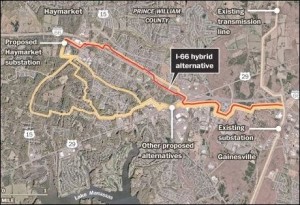Energy efficiency is everybody’s favorite strategy for reducing carbon-dioxide emissions. But conservation programs are not always economical.
by James A. Bacon
Earlier this month Dominion Virginia Power launched an initiative to encourage residential customers to turn in old refrigerators kept in the garage. If you have a clunker that is at least 10 years old and has a capacity of at least 10 cubic feet, Dominion will pick up the appliance, recycle it and pay you $50 in the bargain. By swapping an old fridge for a new energy-efficient model, you could shave up to $100 per year off your electric bill.
Sounds so simple. But there is more to this story than meets the eye, and it provides a glimpse into an under-appreciated question — the extent to which energy efficiency can substitute for new electric power plants in achieving Virginia’s CO2 reduction targets under the Environmental Protection Agency’s Clean Power Plan.
In its 2015 Integrated Resource Plan, Dominion predicated its options for investing in electricity generation and distribution upon the assumption that it will be able to achieve more than 3,000 Gigawatt hours of energy savings through Demand Side Management (DSM) programs by 2030. That savings will eliminate the need to build 611 Megawatts of generating capacity, equivalent to about 3.4% of the power company’s current generating capacity of 17,500 megawatts.
But some environmental groups contend that Dominion should invest more aggressively in energy efficiency to achieve the draft targets set by the Clean Power Plan. “Virginia has a large amount of untapped potential when it comes to energy efficiency,” contends the Natural Resources Defense Council in a 2014 issue brief. The state ranks 47th among the 50 states for energy efficiency. “Other states have been able to achieve significantly higher levels of low-cost efficiency, to accrue substantially more customer and energy benefits. Virginia can do the same.”
Power companies and environmentalists can argue back and forth over whose analysis is the most valid but in Virginia, the State Corporation Commission calls the shots. Power companies must make a business case for a particular energy efficiency initiative and persuade the SCC, which gives great weight to the impact of on rate payers, that the cost of implementing the plan is less than the cost of building new electric-generating capacity. In a recent ruling involving the garage-refrigerator program, the SCC took a harder line than either Dominion or the environmentalists.
A seemingly strong case can be made for recycling the old fridges. “Refrigerator efficiency has improved dramatically in the past 20 years,” said Ken Barker, vice president of technical solutions at Dominion in a press release announcing the roll-out. “Homeowners oftentimes don’t realize how much their old refrigerators may be impacting their energy bills. We not only want to educate our customers on this lesser-known source of wasted energy, we want to help them do something about it.”
Roughly 60 million refrigerators are at least ten years old nationally, and Energy Star models are more than 15% more efficient than those built in conformance with 2009 regulations. The fact that refrigerators kept in garages are exposed to extreme heat makes energy efficiency an even more important consideration. Swapping an old fridge for a new one could save up to $100 per year.
Most studies of consumer behavior, says Dominion in its 2015 Integrated Resources Plan, indicate that consumers expect payback on their energy-efficient investments within 10 years or less. By handling the pick-up and recycling and paying the $50 incentive, Dominion hopes to improve the payback from making an upgrade.
Last August the company filed a petition with the SCC for approval to implement the garage-refrigerator initiative and two other demand-side management programs. A second was a home-improvement program for the poor and elderly, and a third targeted small businesses. In each case, Dominion sought approval to operate the programs for five years.
The SCC was not entirely cooperative. Ruling in April, the commissioners approved the refrigerator program but for only three years on the grounds that its cost-effectiveness was unproven. They said the program should be evaluated over three years before being extended. The SCC also limited the program budget to 50% of the original proposal, or about $4.8 million. The commissioners followed similar logic for the poor and elderly home-improvement program, limiting it to three years and $15.2 million.
The SCC nixed the small business program entirely, declaring that Dominion had not developed it sufficiently. “The lack of detail regarding important elements of the program,” stated the commissioners, “calls into question the accuracy of the Company’s cost/benefit analyses offered in support.”
“We are particularly sensitive to the impact on the bills of customers not participating in the programs, for whom the program costs represent net increases in their monthly bills,” explained the SCC in its final order. In a separate order on an Appalachian Power Co. request, the SCC elaborated: The conservation program “represents an involuntary wealth transfer (i.e., cross-subsidy) from one set of [the Company’s] customers to another.” Non-participants “will pay higher rates with no equal and offsetting monetary benefit.”
Energy efficiency programs vary widely in cost, just as different forms of electric generation do. According to Dominion’s 2015 IRP, costs range from nearly as low as $16 per megawatt hour for a non-residential energy audit program to $158 per megawatt hour for a residential home energy check-up program — and even more for other programs.
Under Virginia’s regulatory structure, energy efficiency programs have a high hurdle to overcome before the SCC will declare them to be in the “public interest.” Not only are Virginia power companies entitled to recover the cost of administering an energy-efficiency program, they normally are entitled to recover revenue lost from electricity not sold.
That helps explain why the SCC is skeptical that energy efficiency will contribute much toward Virginia’s attainment of the Clean Power Plan. In comments submitted to the EPA last fall, the SCC staff wrote: “The Virginia SCC Staff is unaware of any electric energy efficiency resource deployable in Virginia that both (1) has a cost less than its associated avoided variable operating costs, and (2) is scalable to a level that would meet the Proposed Regulation.”
The refrigerator recycling program is a case in point. The program is expected to save about 2,700 megawatt hours of electricity annually, according to Dominion spokesperson Daisy Pridgen. That’s about 7.4 megawatt hours daily, less than one megawatt per hour — a tiny fraction of the total energy-efficiency savings that Dominion is aiming for, and an even smaller percentage of what environmentalists say is possible. It would take dozens of such programs to avoid the cost of building even a single power plant.




